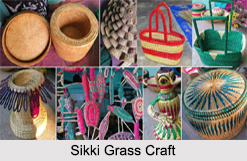 Sikki grass articles or item are ancient craft in the province of Bihar. The golden grass of Bihar is found growing in the wet and marshy area of Madhubani district. Sikki seems to grow almost anywhere in this region even by the roadside. It is most attractive for its tall and lush and with a lovely golden shade. Sikki craft is one of the most practiced craft form in the region and an outstanding art and handicraft of Bihar. It is one of the traditional art forms of Bihar and is a beautiful grass product of India.
Sikki grass articles or item are ancient craft in the province of Bihar. The golden grass of Bihar is found growing in the wet and marshy area of Madhubani district. Sikki seems to grow almost anywhere in this region even by the roadside. It is most attractive for its tall and lush and with a lovely golden shade. Sikki craft is one of the most practiced craft form in the region and an outstanding art and handicraft of Bihar. It is one of the traditional art forms of Bihar and is a beautiful grass product of India.
History of Sikki Grass Craft
The Sikki grass craft has been in existence since hundreds of years. The history of Sikki grass craft demonstrates that the grass craft has been in continuation since hundreds of years. It is hard to establish the precise age of this craft. However, as a craft used for business it is a more recent happening, over the last couple of decades. Crafting products, mostly various forms of utilities, divine figures and toys using Sikki grass are an integral part of the living of the women of the part of Northern Bihar. "Takua", the main tool is a six-inch long needle-shaped iron object with a rounded head which is used to grip the needle. Usually, the "takua" is used by the right hand and the product is held accordingly by the left hand. To make sikki grass more pliable it is dabbed with water. No threads or cords are used.
Even though sikki is a golden coloured grass, various colours are added to it to make colourful attractive products from it. Purple, deep blue, bright yellow, magenta, green and red all combined with the natural golden colour of sikki grass are popularly used. The colouring is achieved by boiling sikki in different colours until the desired shade is reached.
Products of Sikki Grass Craft
Following are the products of Sikki Grass Craft:
•Jhappa- Big containers with caps to store food
•Mauni- Trays for fresh fruits, betel leaf and nuts, flowers, etc.
•Pauti- Beautiful small boxes with caps to keep jewellery, Dry fruits, and other costly items.
•Gumla- Bowl like containers for various uses
•Saji- Flower Baskets
•Idols
•Baskets
•Ornaments
•Toys
Fine Art of Sikki Grass Craft
Sikki grass dyed in red, blue, black and gold is imaginatively wrought into a variety of articles such as baskets and boxes, human figures, replicas of Gods and Goddesses, toys, animals, birds and models of chariots and temples. The desired forms are generally shaped with ordinary grass called "khar" which is coiled and encased in the soften sikki, while many of the motifs are derived from the local tantric traditions.
Procedure of making Sikki Grass Craft
Sikki is obtained from the dried stems of a succulent plant. The upper portion of the stem, which contains flowers, is discarded and the remaining portion cut into small pieces and preserved for making attractive sikki ware. The golden-yellow sikki is used to create lovely dolls, toys, and baskets using the coiling technique. Before being woven the grass is dyed in bright translucent colours and the shimmering golden grass, glowing through the paint, gives the articles their characteristic luminosity. The coiling technique which is the oldest is used in sikki. The common long grass is coiled and stitched together with the sikki, dyed in several different shades using a thick needle called "takua". Especially in constructing the sculpture forms, the whole build up is made by the coils. These forms are completely folk and in a style all their own.
Sikki Grass Craft in Present
The present status of sikki grass craft has changed. Industries in the area have decreased the availability of Sikki grass. But still, some women practice this craft form, mainly in Madhubani, Darbhanga and Sitamarhi regions of Bihar. These days, new products like mobile cases, toys, paperweights, pen stand and other products are made besides the traditional products. Coiling without using "munj" is done by some artisans. Also, there is an evolution of the sikki grass art. A new art form has emerged using Sikki grass inspired from the Madhubani paintings wherein sikki grass is stuck on patterns of Madhubani paintings.



















